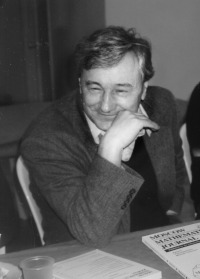
Sergey Petrovich Novikov
This issue contains papers on modern problems of topology, geometry and mathematical physics. Its broad range reflects the main scientific interests of one of the greatest mathematicians of our time — Sergey Petrovich Novikov.
His first student's work Cohomology of Steenrod algebras (1959), in which a new approach to the cohomology theory of Hopf algebras was put forth, distinguished Novikov as one of the leading figures in algebraic topology. His contribution to cobordism theory is fundamental. He calculated the complex cobordism ring (Milnor—Novikov theorem) and developed new algebraic methods based on remarkable properties of complex cobordism theory as of an extraordinary cohomology theory — Adams—Novikov spectral sequence, Landweber—Novikov Hopf algebra, and its operator double (Heisenberg double in the terminology of quantum groups). Jointly with his students Novikov introduced the formal group in cobordism theory and developed methods of its applications. These methods provide important results in the theory of group actions on manifolds. As a whole, Novikov's results were decisive for the development of cobordism theory.
In the fall of 1961, Novikov achieved a crucial breakthrough in the classification problem of simply connected manifolds. Namely, in the case of dimension at least 5, he proved that there is only a finite number of differentiable structures on a simply connected manifold with fixed homotopy invariants and fixed integrals of Pontryagin classes.
Continuous homeomorphisms differ substantially from smooth and piecewise-linear ones. Novikov's famous proof (1965) of the topological invariance of the rational Pontryagin characteristic classes was the first impressive breakthrough in the fundamental topological problem: how to treat continuous homeomorphisms of manifolds? What happens to the most important diffeomorphism invariants? Novikov's toric constructions made it possible to solve problems of continuous topology on the basis of the rich technique developed in differential and algebraic topology. This approach was elaborated and used later by many other mathematicians to solve other famous topological problems.
Generally, Pontryagin classes are not homotopy invariant. For simply connected manifolds there is only one homotopy invariant expression in Pontryagin classes, the Hirzebruch formula for the signature. Its importance in topology, algebraic geometry, and index theory of elliptic operators is well known. Novikov observed that if the fundamental group of a manifold is non-trivial, then there are other homotopy invariant expressions. In 1970 Novikov formulated a general conjecture specifying how to find the homotopy invariant part of characteristic classes. It is hard to overestimate the impact that Novikov's higher signature conjecture has on many branches of mathematics. Nowadays, this conjecture is proved for many special cases. It is one of the most famous topological problems, and an enormous number of papers is devoted to it.
The qualitative topological theory of codimension one foliations is another fundamental topological work of Novikov. Its applications are especially effective for 3-manifolds. In particular, in 1965 Novikov proved that any nonsingular 2-foliation on the 3-sphere admits a compact fiber. Novikov's theory of multi-valued functionals has a great impact on quantum field theory (Wess—Zumino—Novikov—Witten model) and is the starting point of many topological works (Novikov rings, homology and inequalities in Morse—Novikov theory). It became fundamental in modern symplectic geometry and topology.
In the last decade Novikov jointly with his youngest students developed a topological theory for the so-called “semi-classical” motion of Bloch electrons along the Fermi surface in normal metals in a “strong” magnetic field. Topological results lead to unexpected corollaries for the electric conductivity tensor. New observable integer-valued topological characteristics of conductivity are revealed for metals with topologically nontrivial Fermi surfaces.
No doubt, Novikov is one of the leading figures of the last decades of the previous century in bringing together mathematics and physics. Novikov's discovery of an analogue of multisoliton solutions in the periodic problem for the KdV equation was the starting point for periodic soliton theory. Many ideas of this theory had already existed long before in different areas of analysis, algebra, and classical dynamical systems. However, these ideas were neglected by mathematicians, since they were completely isolated from each other (sometimes even totally forgotten). Now they reappear as interweaving parts of a new mathematics, unified on the basis of completely new ideas. These ideas brought a revolutionary geometric understanding of the spectral theory of periodic linear operators; they pointed to a deep connection between mathematical physics and algebraic geometry, long before anything like it appeared in quantum field theory.
It suffices to mention just several directions developed by Novikov in collaboration with his students, to see his impact on the development of modern mathematical physics. Among them we find: algebraic geometry theory for periodic 2D Schrödinger operators based on the concept of complex Fermi surfaces; creation of Novikov—Veselov hierarchy; effectivization of the classification of commuting differential operators, based on a new method of KP-deformations; the discovery of the Krichever—Novikov equation; construction of the Laurent—Fourier theory on Riemann surfaces; generalization of Kac—Moody and Virasoro algebras (Krichever—Novikov algebras and bases); operator quantization of closed bosonic strings; the discovery of remarkable universal algebraic geometry properties of symplectic structures arising in the theory of highly nontrivial finite-dimensional completely integrable systems (Novikov—Veselov); the Hamiltonian theory of hydrodynamics type systems, fundamental in the classification problem of topological quantum field models (Novikov—Dubrovin).
Novikov's program of effectivization of the θ-functional calculus takes a special place in this list of achievements. It provides, as a by-product, a framework for the solution of one of the most famous problems in algebraic geometry — the Riemann—Shottki problem. Novikov's conjecture was proved by Shiota in 1986. This issue is dedicated to Sergei Petrovich Novikov on the occasion of his 65th birthday. We use the opportunity to express our admiration towards Novikov's mathematical genius.
V. M. Buchstaber, Yu. S. Ilyashenko, I. M. Krichever,
O. K. Sheinman, A. B. Sossinsky, M. A. Tsfasman.

